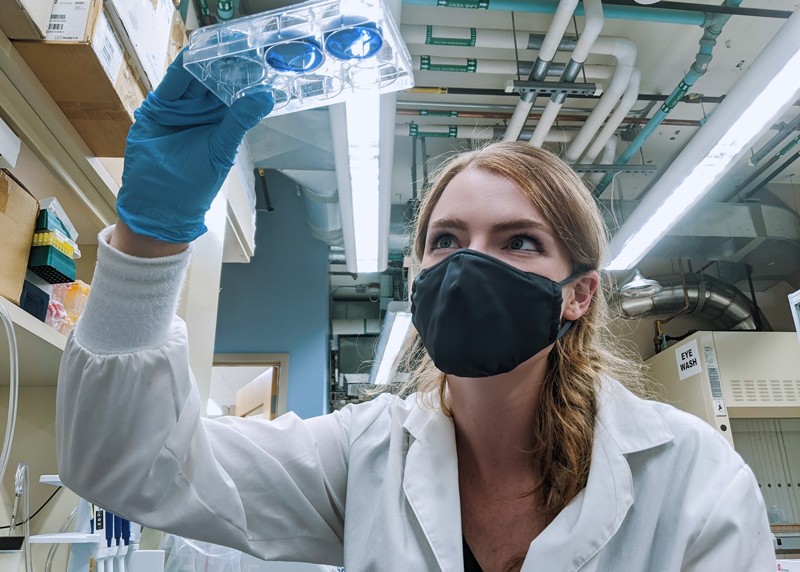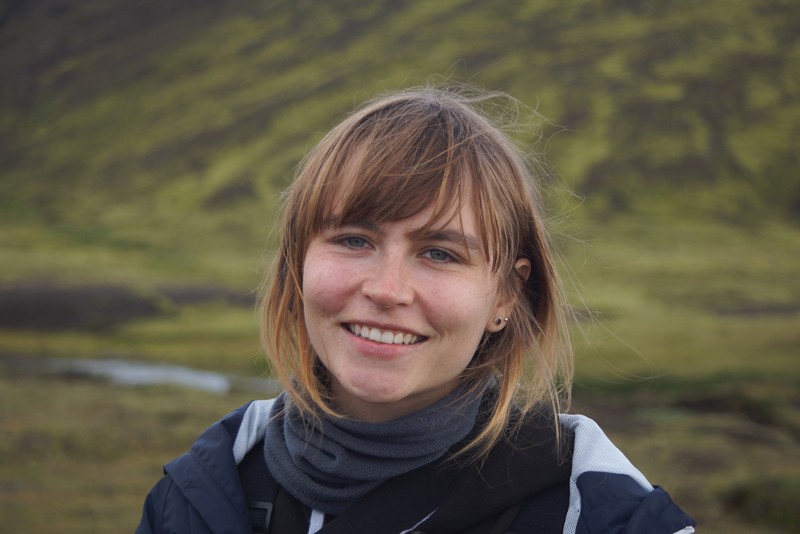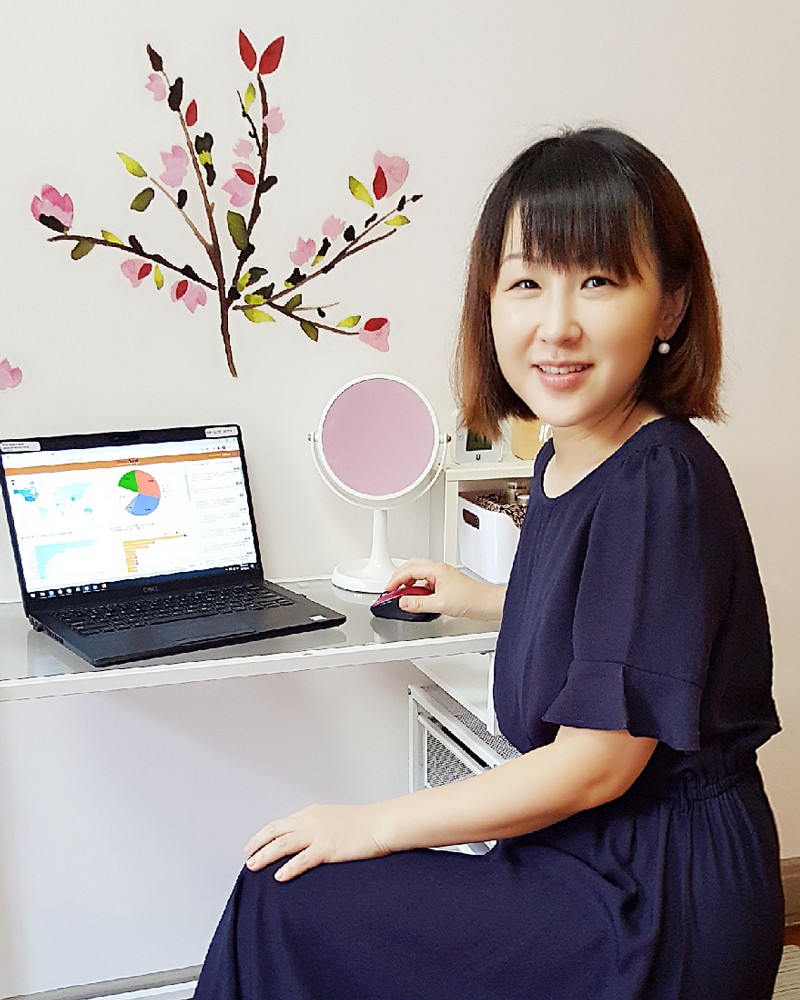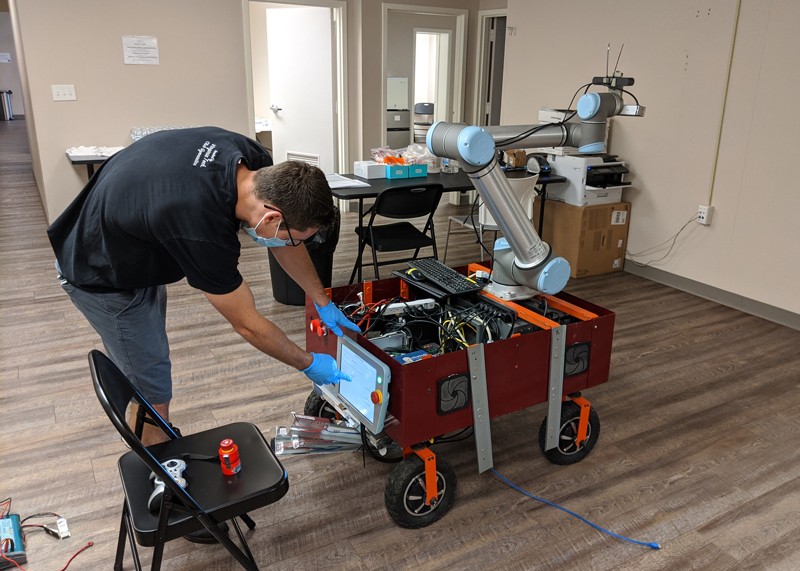As a postdoctoral researcher in disease ecology at the University of Montpellier, France, Amandine Gamble spent the first two months of 2019 hunting down unsuspecting albatrosses on the Falkland Islands. Gamble was finishing some fieldwork on avian cholera, which required her to sneak up on the massive seabirds to take blood samples.
A little more than a year later, the tables were turned: this time, Gamble was being pursued.
Reporters were hounding her, and members of her laboratory team, for interviews about some findings that had been published in a 17 March letter to the editor1 in The New England Journal of Medicine. The correspondence, she says, was the first scientific paper to demonstrate that SARS-CoV-2, which causes COVID-19, could linger on surfaces. It also suggested that the virus might be free-floating in aerosols.
Gamble took part in the study during her current postdoctoral placement at the University of California, Los Angeles, which started in March 2019. In doing so, she had changed gear, moving from her low-profile speciality in disease ecology to research findings that were headlined in The New York Times.
Her shift to studying COVID-19 required her to transition from wildlife epidemiology to human disease, and to refresh her skills in quantitative methodology. Gamble reviewed molecular biology through constant reading, reminding herself of the basics of virus replication, the parts of the cell, assays and cell lines. She was cramming, she recalls, and it was stressful. Plus, Gamble was constantly on call, responding to teammates by phone and through the online messaging tool Slack whenever they sent her new virology data. Her job was to format and analyse the raw data to quantify the virus’s viability on surfaces by calculating its rate of decay.
“We were working all the time,” Gamble says. “Colleagues sent data, and whatever time it was, we looked at them and worked on the statistical results.”
Gamble credits her lab team for the initiative’s success: she and her team set themselves apart from other research efforts by focusing on the environmental viability of the virus, rather than on epidemiology, in which she and her supervisor have a background. Others had long had a head start on those studies, she says. “We avoided this path,” she adds. “We could see that there were many other labs already analysing epidemiological data.”
Her team has continued to study the stability of the virus, not just on surfaces but in aerosols. More papers are on the way, including a preprint posted on the bioRxiv server this month2, and Gamble expects that COVID-19 will probably keep her busy for at least another two years. She hopes that she’ll then be able to return to her original research, but only after completing her COVID-19 work. “Even if everybody got vaccinated tomorrow, I’d still like to finish my project on aerosol stability,” Gamble says, “so that next time we have a pandemic, we have knowledge we acquired from this one.”
Why change?
Gamble is one of many early-career researchers who, despite the shutdown and slow recovery at academic labs worldwide, have found their way to fruitful COVID-19 research from specialities outside virology or related disciplines.
Some of them might normally work in health and life sciences — including psychiatry, cardiovascular disease, asthma, cancer and neuroscience research. Others might be specialists in environmental science, robotics or artificial intelligence (AI). Still others might be physicists, now testing mask permeability; atmospheric scientists, studying weather conditions and viral spread across populations; or architects, examining ventilation design, for example.
The response to the pandemic by scientists from so many disciplines didn’t evolve from painstaking deliberation. Instead, the shutdown of universities and other research institutions prompted investigators to change direction quickly, often in a matter of days, reflecting the urgency of the moment. “Everything happened so fast,” Gamble recalls. “I didn’t spend much time questioning myself. At the beginning, it started like a side project,” she says of her COVID-19 work. “‘Can you analyse this data?’ We acted quickly — the first paper was done within two weeks to a month. And then we were supposed to go back to normal life, but things kept happening.”
Gamble did not, in fact, go back to ‘normal’, and she has broadened her expertise, professional networks and publishing opportunities as a result.
Making a successful turn to COVID-19 involves some luck, to be sure; it also requires a skill that might best be called strategic opportunism — the ability to map out a path from one’s own expertise and resources to an intersecting area of emerging research.
Scientists who have changed their research focus to study aspects of the pandemic or infection have largely adopted similar strategies: reading voraciously to find the points of intersection between COVID-19 and their speciality; staking out research spaces that are not overcrowded; capitalizing on their unique assets, such as access to blood samples or equipment; agreeing to venture beyond their comfort zone; and seeking collaborations with other investigators (see ‘Team up to change tack’).
Getting started: read and review
Gamble knew that she couldn’t change direction successfully without reviewing the basics of cell biology. She consulted a range of sources, from scientific papers to Wikipedia.
Extensive self-driven study is also required to master the emerging science of the infection itself. Immunologist Sonia Sharma at the La Jolla Institute for Immunology in California has switched successfully to COVID-19 research from a focus on rare inflammatory disease and cancer immunology.
She recommends that those who hope to make a similar shift read broadly to get themselves started — The Lancet, The New England Journal of Medicine and other clinical journals — and then home in on the hypotheses that intersect with their particular expertise, which in her case is the immune system. “You want to look at clinical literature, assess the important public-health questions and determine how you can address something,” Sharma says.
Intensive, strategic reading was key to environmental scientist Gourav Dhar Bhowmick’s success in changing course from his doctoral thesis on energy-generating wastewater-treatment systems to producing a paper published in July warning of the effects of SARS-Cov-2 in the water supply3.
Bhowmick turned his attention to COVID-19 research in March, at the same time as he finished his PhD at the Indian Institute of Technology in Kharagpur. He began by launching a literature review of previous coronavirus outbreaks — including epidemics of severe acute respiratory syndrome (SARS) in 2003, and Middle East respiratory syndrome (MERS) in 2013 and 2015 — to investigate whether these viruses could survive in wastewater. He found that they could. What drove him was the concern that people in some developing countries live close to collected wastewater and drink from water supplies contaminated by faeces. “The paper gave me a lot of recognition from my institution and fellow researchers. It helped me in building my career,” he says, “and doing something good for my people.”
In August, he started his first postdoctoral programme, at Ben Gurion University of the Negev in Israel. His focus is membrane-based water-purification systems, although he hopes to expand his research efforts on COVID-19.
Unlike some junior scientists whose principal investigators (PIs) invited them to join COVID-19 research initiatives, Bhowmick created his own opening. “You have to grab the opportunity and take the lead,” he says. “Begin with a literature review and start brainstorming from there.”
Connect your speciality to COVID
Pathobiology PhD student Kelsey Huntington was in her first year studying the role of the immune system in colorectal cancer at Brown University in Providence, Rhode Island, when her lab shut down in March. At that point, her PI encouraged the team to consider new research opportunities, and Huntington was among those who signed up, motivated in part by the fear of being shut out of the lab indefinitely. “That uncertainty was really scary in itself. It felt like we were putting our degrees on hold, so the opportunity to get back in lab and make progress in research, even if it was not thesis research, was really exciting to me,” she says.
The lab shut down on a Wednesday, she recalls, and she spoke to her adviser the following Saturday. “I was back in the lab on Monday.” By September, she had earned her first co-first-author credit on a paper that was accepted for publication, finding that a class of drug called MEK inhibitors can suppress inflammatory cytokines, stimulate natural killer cells and help to control disease progression4. Huntington’s success came from connecting the dots between her cancer research and COVID-19. “We read about COVID-19 and realized that our lab’s expertise in therapeutics and my current project on the immune system in colorectal cancer might be applicable,” she says.
She and her lab mates then set up experiments using different drugs, and found that one class of therapeutic had promising effects. “The publishing opportunity was important, and also the hands-on experience in the lab, since I was a first-year student,” says Huntington, who is now in the second year of her PhD programme and transitioning back to her focus on cancer. She adds that her COVID-19 research helped to provide her with a sense of purpose during a public-health crisis. “The ability to contribute in a small way was a big deal,” she says.
Outside the life sciences, scientists are making connections between their work and COVID-19. Yinping Yang, a behavioural scientist at Singapore’s Agency for Science, Technology and Research, the city-state’s leading government science institution, used AI tools to better understand worldwide responses to COVID-19.
For a paper published in April5, her team used its software technologies in text-based emotion recognition to categorize the sentiments of 20 million Twitter messages on COVID-19 posted between 28 January and 9 April. Among the findings was a transition in popular sentiment from fear to anger during the pandemic’s early months. Yang is working on three more studies that will analyse COVID-19 responses across geographical regions and cultures, among other frameworks.
Public health had not been prominent in Yang’s earlier research, which ranged from business applications of AI in procurement and negotiation to the development of tools for comprehending written language, including the use of sarcasm, in social media.
Yang launched her project in January, after Singapore’s government offered grants for studying population responses to the virus, alongside opportunities for standard virology and diagnostics research. Her work’s value lies in helping leaders to gauge the intensity of distress across a population, which could provide guidance for policymakers and others.
Maximize assets
Scientists can switch more quickly to COVID-19-related research when they can tap into assets that they already have. These could range from blood samples to mouse models to technologies such as microscopy — or even a robot.
A group of researchers at the University of Virginia (UVA) in Charlottesville was building a robot for disaster response, as part of an international competition, when the pandemic shut down their lab. The team quickly repurposed its creation into a COVID-19 health tool — a 180-kilogram robotic unit on wheels, with an arm that decontaminates entire rooms, including hard-to-reach surfaces. It works by projecting ultraviolet-C light, which is known to destroy the SARS-Cov-2 virus. “It’s really exciting and cool to see the prototype helping to solve real-world problems,” says Dean Conte, a master’s student in mechanical engineering at Virginia Polytechnic Institute and State University (Virginia Tech) in Blacksburg. Although a Virginia Tech student, Conte is on the UVA lab team that developed the robot.
Conte will graduate in early 2021 and is considering doing a PhD to expand on the work he started during the pandemic. “It’s shown me there has not been enough work done in robotic disinfection,” he says.
Innovate
Aaron Bivins, who earned a PhD in environmental engineering last year, had studied drinking water for his doctorate. He had hoped to turn his attention to wastewater when he began his postdoctoral programme in November 2019 at the University of Notre Dame in Indiana: his plan was to research antibacterial resistance in the environment.
The day after the first local case of COVID-19 was reported in March, he began procuring wastewater samples to test for the presence of SARS-CoV-2, along with his lab mates and PI, Kyle Bibby. Bivins wanted to explore whether the concentration of the virus in wastewater could help to determine the infection rate in an entire community.
Meanwhile, he and Bibby hatched an idea to focus disparate and sometimes competing research efforts among institutions on a single purpose. “This seems like it’s going to be very important,” Bivins recalls thinking. “We should try to corral everyone.” He drew up a statement proposing that environmental scientists work together on COVID-19 research, and by the time the American Chemical Society published it in April as an opinion piece6, 59 co-authors had signed on.
He formed the COVID-19 Wastewater-Based Epidemiology Collaborative, which has enabled 842 scientists from around the world to share information, advice and findings, and to upload published work on a Slack site. “My thinking was, there’s no reason for every research group to reinvent the wheel. Why not freely disseminate information so we can respond more efficiently to this pandemic?” says Bivins.
Not only has the initiative taught him innovative ways of working, but his research has yielded five papers, doubling his publishing output. He’s also picked up leadership experience. “As a postdoc, it’s important to move from being a PhD student and step into some new roles,” he says.
Bivins’s COVID-19 work is continuing. He hopes to circle back eventually to the study of antibiotic resistance in the environment. “But for now, there’s a lot of work to be done,” he says.
Strengthen connections
In calling for cooperation, Bivins demonstrated the value of collaborating effectively. Such partnerships can be informal: cheering on lab teammates and holding group study sessions to review COVID-19 literature; reassigning roles so that colleagues can work together in new ways; or reaching across disciplines, institutions and areas of expertise to form a research network.
Collaboration — along with quick thinking and flexibility — allowed Fabio Tavora, who runs a commercial pathology lab in Fortaleza, Brazil, to support his community and help to sustain a cadre of junior academic scientists at a time of imperilled research funding. Tavora, a physician, is also a pathologist at the Federal University of Ceara in Brazil.
Moving back home to Brazil in February after completing a postdoctoral programme in cancer-drug development at Brown University, Tavora repurposed Argos Laboratory, where he is medical director, into a COVID-19 testing operation. He then enlisted graduate students in pathology, whom he advises and whose research was stalled by budget cuts. He hired and trained eight of them to serve as a mobile, 24-hour on-call testing team. “They loved it because the first thing the government did [after COVID-19 hit] was to cut their research stipends,” Tavora says. Bringing in the young scientists allowed for quick post-mortem testing and results and thus for more-effective contact tracing.
Tavora’s lab managed to perform approximately 60,000 tests between April and late October, speeding up turnaround time on results from 2 weeks to 48 hours, and working for government hospitals that largely serve low-income patients. The lab will continue testing while resuming its pathology mission. “I have probably diagnosed patients’ cancer from thousands of pathology reports and hundreds, if not thousands, of types of cancer,” he says. “Nonetheless, I feel that what my team achieved in these past months was of paramount importance to the population.”
"how" - Google News
November 20, 2020 at 06:40PM
https://ift.tt/38WNmNr
How to shift into COVID-19 research - Nature.com
"how" - Google News
https://ift.tt/2MfXd3I
https://ift.tt/3d8uZUG
Bagikan Berita Ini


















0 Response to "How to shift into COVID-19 research - Nature.com"
Post a Comment